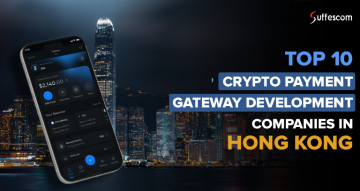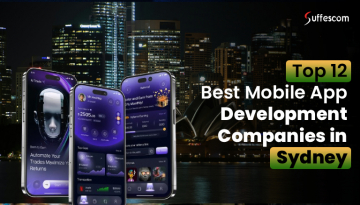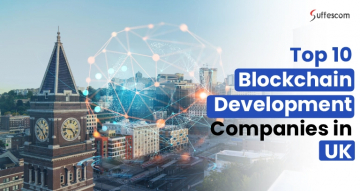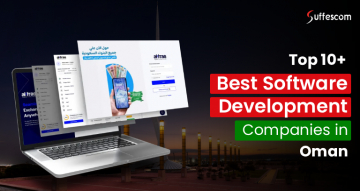Digital Twin Development Cost | How Much Does It Cost To Build Digital Twin

As the demand for smarter amenities grows, every executive must address one crucial question: what will it cost? Price sets the stage for ROI, making it a critical aspect to comprehend. Considering cost helps you better grasp the break-even point, estimated ROI, and other crucial financial parameters. Cost measurement is more complex. How do you calculate the digital twin application cost, for instance?
Digitalized assets are digital twins. Twins are not physical, even though software and sensor aspects assist with their layout. They are widely integrated throughout the company and reside in the cloud. How can the investment cost of something so ubiquitous be calculated?
Well, for that, you need an expert like Suffescom Solutions Inc. With decades of expertise in web3, metaverse, and blockchain development, the company can bring any vision into existence. Suffescom is a leading digital twin development company that helps companies worldwide increase their digital presence and look for new growth prospects.
This post examines why companies should consider adding unique digital twins and the cost factors they should evaluate before starting the development process.
Let us dig deeper into the topic to understand the very basics.
Want To Redefine Your Blockchain Business Idea?
Give Us A Chance! Exchange Your Ideas With Our Experienced Blockchain Experts.
How We Create Digital Twins?
Real-time monitoring of an entity's efficiency is accomplished via digital twin software, which offers a digital model or emulation of the tangible commodity. Ultimately, the asset is optimised for optimal efficiency using these technologies to mimic performance, anticipate future service requirements, and so forth.
Businesses integrate sensors into their physical assets to generate the data required to support a digital counterpart. They can observe and track the actual machine by converting the resources into IoT-capable gadgets. These tools are frequently used in collaboration with computer-aided engineering (CAE) software or IoT device software solutions.
For a product to be eligible for the Digital Twin category, it must:
- Deliver virtual representation to a physical resource.
- Utilize sensors to follow data generated by the tangible asset.
- Permit users to enhance the actual asset's functionality based on the information the investment produces.
Read More: How Do You Build a Digital Twin?
Market Challenges In 2022
Data integrity, brought on by the increased usage of IoT and Cloud platforms, is one of the key barriers preventing the mainstream use of digital twin technologies.
Security has become a top worry for industrial process control users and suppliers due to increased assaults on crucial cloud architecture over the past ten years. As a result, it is anticipated that a significant barrier to the expansion of the marketplace for digital twins will be the rising threat to the privacy of technological communication to the cloud.
The need to understand the expenditure of adopting digital twins is another significant obstacle on the road to effectively creating and adopting digital twins.
Market Growth Essentials
In 2020, the market for digital twins was estimated to be worth $3.1 billion; by 2027, it is expected to be worth $73.5 billion. Over the forecast period, growth is anticipated to occur at a CAGR of 60.6%.
The main reasons influencing the use of digital twins in enterprises today, as per some studies & markets, are:
- The development of data science, industrial Internet of Things (IIoT), and artificial intelligence (AI) technologies.
- The quickening growth of digital production and health applications.
- Rising demand for authentic surveillance and advanced predictive data.
- Shortened Time to market and enhanced decision-making.
- The necessity of cost reduction and optimization, etc.
Beyond The Cost, Look At The Digital Twin Perks
The advantages of digital twins, such a comprehensive solution, are beyond dispute:
Enhanced R&D
Digital twins generate a plethora of information about anticipated organizational results. This makes product creation and analysis more effective. Organizations can thus use this information before execution to gather perspectives that will allow them to carry out the required material enhancements.
Correct Insights
The development of a digital twin system provides decision-makers with more comprehensive support. This is useful for a variety of tasks since it allows for the evaluation of the present situation, the assessment of earlier problems, and the prediction of future tendencies. Digital twins synchronize with physical entities and adapt to the specific issues at hand, providing tactical awareness and real-time information.
Periodic Maintenance
A digital twin product reduces expenses and saves time while enhancing the efficiency of a company. Even if they have a burning urge to include digital twins in their daily operations, many small and medium-sized businesses (SMEs) are unaware of the key technology and tools associated with this idea. Digital twins must also be orientated, run, and optimized over a long period because they are such a complex system.
Enhanced Workflows
In addition to gathering sensory data, AI, and big data analytics, digital twins can effectively monitor, identify, forecast, and optimize a tangible asset. Virtual twins can impact a company's digital transformation by offering new business strategies or increasing efficiency through digitalization.
Upscale Business With Trusted Blockchain Development Company
We leverage our blockchain expertise to build secure, scalable, and reliable business-oriented solutions. We levy all our resources to bring your project to life. Choose the service you need to upscale your business and get in touch to begin the process.
Points To Remember Before Deploying Digital Twin
Evaluate your data protection mechanisms
By 2023, 75% of the digital twins for IoT-connected items would use a minimum of five connectivity interfaces. The volume of data gathered from these endpoints is enormous, and each connection poses a possible security hole. Thus, before implementing digital twin technology, businesses should review and upgrade existing security policies.
Control the quality of your data
The data from millions of sensor data that connect over unstable networks is what drives digital twin models. Businesses that want to use digital twin technologies should be capable of controlling gaps in the datasets and rejecting flawed data.
Educate your crew
Individuals who utilize digital twin technology might adapt to new work methods, which could cause issues when developing unique technical expertise. Businesses must ensure that their employees have the knowledge and resources to operate with digital twin models.
Digital Twins For Different Business Models
To help you understand digital twins' differences and practical uses, we'll go through some of the most prevalent cases in this section. You will then be able to create a digital twin that best meets the demands of your company.
Component Twin
Component twins symbolize a single aspect of the system. This directly impacts the system's efficiency and usability. Part twins adhere to the same notion even though they pertain to less significant components of a system or product.
Asset Twin
Asset twins also referred to as product twins, show how certain corporate variables relate. They generate an abundance of statistical information. It can be examined to yield valuable information. The system's refinement is made possible by the digital twinning of specific components.
Process Twin
Digital representations of information systems are referred to as "process twins." This digital twin determines whether these components are synchronized to work as quickly as possible. It can also show whether the process is operating late and how that can affect other people.
System Twin
These twins look at the relationships between several components that make up an entire, workable system. They describe how resources interact and could suggest efficiency gains.
Digital Twin Deploying Phases
The discovery, UX/UI design, app development, quality assurance, release, and support phases can be categorized into the primary steps in creating a digital twin.
Design Research
We develop hypothetical customer personas and discuss their user processes and experiences. We also create low-fidelity mockups and wireframes at this stage to provide a structural view of the digital twin.
Technical Research
We create collateral with in-depth details regarding the project structure, technical stack, essential information flows in a digital twin, and development and QA procedures.
UI/UX Design
To establish how the actual thing will seem, we design UX/UI schematics, demonstrations, and high-fidelity UI renderings in a virtual era.
App Creation
We draft a document outlining the product specifications and build the digital twin's front and back interface to link it to the working prototype and provide secure access, interconnections, data analytics, and control mechanisms.
Quality Control
We create the strategic test framework, consider each potential testing process, and create a test description.
Release
A completely functional digital twin is implemented at this point. Deployments of digital twins typically begin modestly, for as, by tracking the effectiveness of a single component within an object before growing over time.
We can assist you if you're seeking an IoT development company to create a digital twin for your organization. Set up an appointment with one of our trained professionals to review your needs.
Now you’re quite familiar with a digital twin and its deployment process, let’s discuss the title of our post: Digital Twin development cost factors.
How does IoT Work With Blockchain?
The stunning combination of IoT and blockchain across the internet sends and receives data on restricted blockchain networks. It protects the system from tamper-resistant records.
Digital Twin Application Cost Factors
The primary costs of creating a digital twin are determined by the framework of the model's abilities and the amount of information it must manage. To understand the financial situation, we'll go a bit further and talk about the essential components of producing a digital solution.
Digital Version
The capability to develop a digital model of storefront assets is one of the key components of digital twin architecture. That represents the actual world virtually. There are various digital models based on the specifications of each app and the kind of solution to be offered.
Analytics Assistance
Numerous digital twin designs use simulated data provided by the twin model and actual data obtained from complex processes to employ data and insights. These designs need full statistics support at the protocol stack. Scenario planning, efficiency analytics, and data modeling are a few analytical methods covered in this topic.
Regular Updates
The ability to upgrade digital models and information retention is known as a temporal update. There are two methods for doing this. The status of the modeled items, in their most basic form, continuously reflects the conditions on the production floor. For instance, the centralized data layer of the digital twin gets regular information exchange from devices that allow for almost real-time upgrades.
Management of Data
The information allows a digital twin to recognize, respond to, and modify the environment and operating conditions. Data collection, transfer, storage, analysis, acquisition, and visualization are the five areas into which tools for handling this data can be categorized.
Altogether Now,
The behavior of operations and goods is improved by digital twins, which typically results in more effective functioning. We can foresee potential issues in the future with digital twins. Along with other benefits, this decreases product failures and accelerates manufacturing.
By using real-time data, digital twins can enhance and optimize industrial operations. They enable us to mimic various conceivable scenarios, reducing downtime due to probable errors and mishaps. By carrying out regular maintenance chores, digital twin technology lowers maintenance expenses. Through models and the identification of errors and inefficiencies, it offers chances for ongoing improvement.
You should use the digital twin, a fantastic Industry technology, to transform your company into one prepared for tomorrow.
Contact us now!








